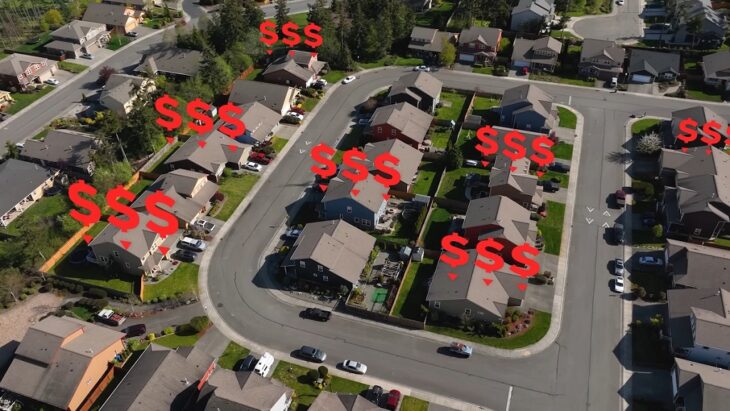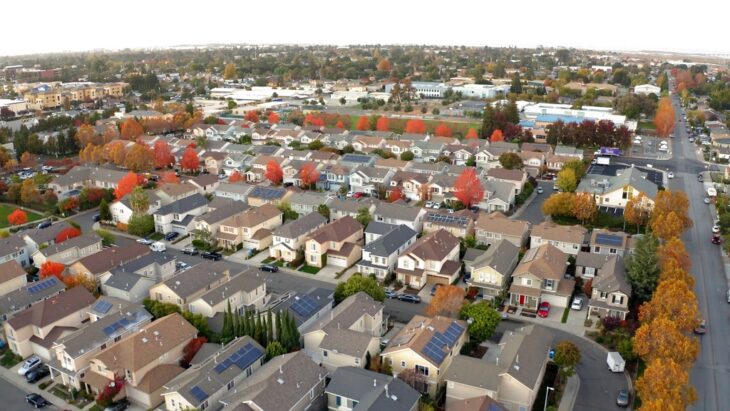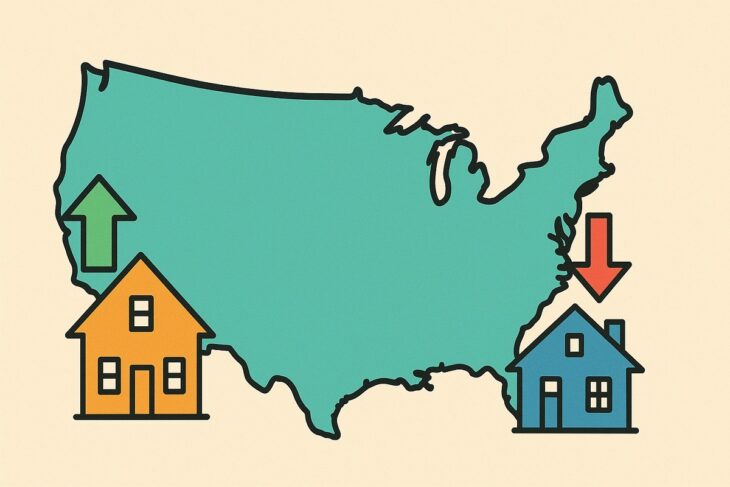U.S. housing in 2025 continues to shift as economic pressures and consumer behavior reshape the market.
Mortgage rates, inventory levels, and buyer sentiment all influence where values rise and where they drop.
Higher borrowing costs have cooled some overheated regions, while affordable metros still attract strong demand.
Table of Contents
ToggleNational Housing Market Trends (2025)
Housing activity in 2025 reflects an economy still adjusting to inflation control policies, labor shifts, and evolving consumer priorities.
Mortgage rates, inventory levels, and regional affordability continue shaping both short-term opportunities and long-term expectations.
Buyers and sellers alike are navigating a market that’s no longer feverish but still full of strategic potential.
Mortgage Rates

Mortgage rates have begun to ease slightly after several years of upward pressure.
Analysts project 15-year fixed loans to stabilize near 5.5% by the end of 2025, a noticeable improvement compared to 2023–2024 highs.
That drop is likely to reignite buying activity among consumers who delayed purchases due to affordability barriers.
A lower rate environment enhances borrowing power and may help offset price appreciation in competitive metros.
Sellers, however, must recalibrate expectations as the era of bidding wars and instant offers gives way to cautious, data-driven decision-making.
Key Mortgage Rate Highlights:
- Projected average for 15-year fixed loans: ~5.5% by late 2025
- Effect on buyers: Increased affordability and revived activity
- Effect on sellers: Reduced leverage and longer listing times
- Overall impact: Gradual normalization after two years of rate volatility
Intentory Levels

Inventory expansion marks another defining trend.
Housing stock has risen for more than 20 consecutive months on a year-over-year basis, signaling a healthier flow of supply.
Although still below pre-pandemic levels, this increase creates more balance between supply and demand.
More listings mean buyers can compare, negotiate, and act without the frantic pace that characterized 2021–2022.
Sellers who once dictated terms are now entering a competitive environment where strategic pricing and presentation make all the difference.
Inventory Insights:
- 20+ months of consecutive growth in available listings
- Still roughly 15–20% below pre-pandemic averages
- Higher supply = more negotiating power for buyers
- Price cuts on roughly 1 in 5 listings indicate market rebalancing
A general transition toward equilibrium defines the national housing scene.
Demand remains steady in affordable metros, while overheated markets cool under the weight of pricing fatigue.
Instead of the all-out seller dominance of previous years, buyers now have more room to act deliberately.
Market Outlook for Buyers and Sellers

Buyers are regaining leverage in 2025.
With inventory levels improving and fewer bidding wars, negotiation opportunities are expanding.
More listings allow for selective decision-making, though prices remain elevated in many competitive regions.
Sellers face new challenges. Success depends on accurate pricing, effective staging, and strong marketing.
Overpricing risks extended time on market, while flexible sellers can still close quickly with realistic expectations.
For those looking to sell quickly without the hassle of repairs, commissions, or waiting months, services like Unload My Home offer a practical alternative, especially in markets experiencing slower absorption or price corrections.
Market movement in 2025 suggests stabilization.
Price growth slows in most regions but remains healthy in economically dynamic areas.
Long-term fundamentals like employment trends and migration will continue to guide housing health more than short-term rate fluctuations.
Regions Where Home Prices Are Surging
Southern metros continue to lead in value appreciation.
States such as Florida and Texas experience sustained growth due to expanding populations, job creation, and infrastructure investment.
Economic migration into these regions keeps fueling housing demand, especially in cities offering a mix of affordability and opportunity.
Select Midwestern cities are also gaining momentum. With home prices far below coastal averages, areas like Indianapolis and Kansas City attract remote professionals and investors seeking value and stability.
Suburban markets benefit as many households continue relocating outward to avoid urban costs. New developments in commuter-friendly areas near major metros keep prices trending upward.
Example Markets:
- Tampa, FL: Booming job growth and tourism appeal drive steady demand.
- Nashville, TN: Entertainment, tech expansion, and lifestyle amenities maintain strong price appreciation.
- Charlotte, NC: Banking sector growth and new residents keep housing hot.
- Indianapolis, IN: Affordability and economic balance draw consistent migration.
Regions Where Home Prices Are Falling
Several high-cost metros are experiencing sharp corrections in 2025.
San Francisco, Seattle, and Portland lead the list of declining regions due to affordability challenges, population stagnation, and tech sector volatility.
Job cuts and slower hiring in technology have reduced relocation demand and pressured existing homeowners.
Remote work flexibility remains a strong catalyst for this trend. Workers who once needed proximity to major tech hubs can now settle in smaller, less expensive markets.
Coastal metros are grappling with shrinking demand as residents leave for lower-cost, higher-quality-of-life areas.
Primary Causes of Price Declines:
- Overvaluation during the 2020–2022 boom
- Tech industry layoffs and hiring freezes
- Persistent affordability barriers
- Rising crime and urban maintenance issues
Sunbelt areas such as Phoenix and Austin, once red-hot, are also cooling down. Pandemic-era buying sprees inflated prices faster than local wage growth, leading to affordability fatigue.
Developers now face slower absorption and offer incentives such as rate buydowns and closing cost credits to stimulate purchases.
Urban centers across the nation show a consistent softening pattern.
Expensive living costs, higher taxes, and growing crime concerns have dulled interest in downtown condos and luxury high-rises.
Meanwhile, suburban and exurban communities are benefiting from the shift in priorities toward safety, space, and financial flexibility.
Markets Likely to See Further Declines:
- San Francisco Bay Area, CA
- Seattle, WA
- Portland, OR
- Austin, TX
Key Factors Driving These Trends

Interest rate sensitivity plays a major role.
Expensive metros react more sharply to mortgage changes, as even minor increases significantly impact affordability.
Meanwhile, lower-cost regions weather fluctuations more effectively, sustaining buyer interest.
Construction and supply chain costs continue to influence new builds.
Labor shortages and material expenses have limited housing supply, particularly in areas already constrained by land-use regulations.
Migration remains a dominant trend.
Outflows from costly coastal hubs toward smaller, affordable metros persist, shaping housing values nationwide.
Remote work enables flexibility, amplifying regional disparities.
Political and regulatory influences add another layer. Zoning restrictions, rent control measures, and tax incentives can either stimulate or stall development.
Markets with pro-housing policies tend to attract more consistent investment.
The Bottom Line
Regional variation defines the 2025 housing market.
Southern and Midwestern regions lead in price growth, while coastal and tech-driven metros experience pullbacks.
Inventory recovery and easing mortgage rates offer cautious optimism, but outcomes depend heavily on local conditions.
Homebuyers and sellers should focus on financial readiness, not just timing, to navigate a market that increasingly rewards informed, flexible decision-making.

